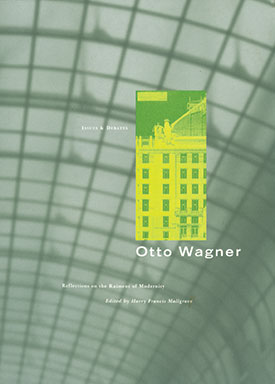
Otto Wagner: Reflections on the Raiment of Modernity
Edited by Henry Francis Mallgrave
1993
436 pages
PDF file size: 121 MB
Description
A traditionalist designer with imperial ambitions or an avant-garde general leading the charge of a modernist assault, a Secessionist architect with a penchant for iconography or a materialist proponent of realist values—Otto Wagner can be portrayed in many ways. As the ten essays in this volume argue, however, a more complete portrait is achieved when variant and seemingly contradictory aspects of his rich architectural and literary oeuvre are allowed to coexist and find their own historical balance. This book is focused less on the visually seductive aspects of Wagners creations than on the social, intellectual, and artistic framework within which the architect brought his works to fruition. The result is a broad but at the same time concentrated exploration of the parameters of Wagner’s tectonic expression—a canvas of a period in which the sensualist aesthetic tendencies of the late nineteenth century merged with the more sachliche vision of twentieth-century art.
Los Angeles is a city on the Pacific Rim where things appear on edge, for they lack a permanent footing even while occupying a specific locale. The city’s genius loci produce this dual vision of fixed place in a state of constant dislocation.
It is only appropriate for the edge-bound Getty Center to initiate a series of publications that aim to expose the historical study of artifacts to the oscillation of rigorous debate. Each of these books proceeds from a specific body of historical material, not because that material is in itself inherently imbued with controversy but because its exposure to different disciplinary approaches raises new questions of interpretation. In the realm of historical studies, issues often emerge at the intersection of the various perspectives scholars have constructed for the examination of their subjects. As their debate refracts and refocuses the material under scrutiny, it also invites reflection upon itself and thereby exposes the assumptions and tendencies of scholarship to no less assiduous criticism than it does the underpinnings of its subjects.
Volumes in the Issues & Debates series will result from symposia and lecture series, as well as from commissioned writings. Their scholarly editors are invited to frame highly focused essays with introductions, commentaries and/or sources, documents, and illustrations that further contribute to their usefulness.
Table of Contents
- Preface
-
Introduction
Harry Francis Mallgrave -
Part I: Opposed or Confronted?
-
Otto Wagners Unsuccessful Parallel-Aktion
Renata Kassal-Mikula -
The Franz Josef-Stadtmuseum: The Attempt to Implement a Theory of Modern Architecture
Peter Haiko -
Realism versus Verniedlichung: The Design of the Great City
August Sarnitz -
Iron and Stone: The Architecture of the Großstadt
Fritz Neumeyer
-
Otto Wagners Unsuccessful Parallel-Aktion
-
Part II: Contrary or Complementary Faces?
-
Modernist Dioscuri? Otto Wagner and Hendrik Petrus Berlage
Iain Boyd Whyte -
The Aesthetics of the Mask: The Critical Reception of Wagners Moderne Architektur and Architectural Theory in Central Europe
Ákos Moravánszky
-
Modernist Dioscuri? Otto Wagner and Hendrik Petrus Berlage
-
Part III: The Changing Dialectics of Modernity
-
From Historicism to Architectural Realism: On Some of Wagners Sources
J. Duncan Berry -
From Realism to Sachlichkeit: The Polemics of Architectural Modernity in the 1890s
Harry Francis Mallgrave -
Sachlichkeit and Modernity, or Realist Architecture
Stanford Anderson -
The Evolutionary Way to Modern Architecture: The Paradigm of Stilhülse and Kern
Werner Oechslin
-
From Historicism to Architectural Realism: On Some of Wagners Sources
- Biographical Notes on the Authors
- Index
About the Authors
Stanford Anderson has written and lectured widely on the historiography of modern architecture, urban planning, and ecology. He is head of the Department of Architecture at the Massachusetts Institute of Technology.
J. Duncan Berry focuses his studies on the architecture and theory of late historicism. He has held teaching positions in art and architectural history at Brown University, the School of Architecture at Roger Williams College, and the Rhode Island School of Design.
Iain Boyd Whyte is director of the Centre for Architectural History and Theory at the University of Edinburgh. His fields of study are nineteenth- and twentieth-century architectural history and theory with emphasis on Germany, Austria, and the Netherlands; aesthetics; film theory; and Anglo-German literary relations from 1700 to the present.
Peter Haiko has centered much of his scholarship on turn-of-the-century Viennese architecture, especially the work of Otto Wagner. He holds a professorship at the Institut für Kunstgeschichte of the Universität Wien.
Renata Kassal-Mikula is a senior curator at the Historisches Museum der Stadt Wien. She is also an authority on the work of Otto Wagner and on nineteenth-century Viennese architecture.
Harry Francis Mallgrave is an architect and an architectural historian. He is the author of numerous articles on nineteenth- and twentieth-century German and American architecture and has lectured extensively on architectural theory. Since 1988 Mallgrave has been architecture editor for the Texts & Documents series.
Ákos Moravánszky has published widely on Central European architecture of the twentieth century. Since 1991 he has taught architectural history at the Massachusetts Institute of Technology.
Fritz Neumeyer has written extensively on the history and theory of modern architecture. An architect, he holds the chair for architectural theory at the Technische Universitäaut;t, Berlin.
Werner Oechslin teaches the history of art and architecture at the Eidgenössische Technische Hochschule in Zurich and is director of its Institute for History and Theory of Architecture.
August Sarnitz is an architect and architectural historian who concentrates on twentieth-century American and European architecture and architectural history and theory. He has taught at the University of California at Los Angeles and at the Rhode Island School of Design and is currently associated with the Otto Wagner-Archiv of the Akademie der bildenden Künste in Vienna.
Press Reviews and Awards
- “If the origins of modern architecture engage but confuse you, and you care about ideas as well as images, drop that coffee-table tome about Vienna or Glasgow or Chicago 1900: here is the book for you.” —Architects Journal